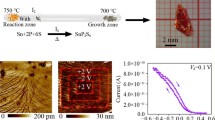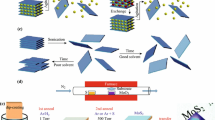Abstract
High mobility transparent conductive Zr, Ti and Ga-doped indium oxide (ITGZO) films were deposited by radio frequency (RF) magnetron sputtering method at the low deposition temperature. The effects of deposition temperatures on structural, electrical, and optical properties of ITGZO films were investigated in this work. High mobility of 94 cm2/V S was achieved at the deposition temperature of 70 °C along with the annealing process. Furthermore, the optical transmittance of ITGZO films has increased by 18% at the infrared wavelength region from 1500 to 2580 nm; compared to the typical Sn-doped indium oxide (ITO) films, this excellent transmittance is mainly attributed to the less free carrier absorption (FCA) thanks to the low carrier concentration of less than 2.0 × 1020 cm−3. In addition, the surface morphology of ITGZO films demonstrated that Ga element would precipitate on the film surface when oxygen was insufficient during the film growth, which indicates that Ga element exists as an oxidation state rather than interstitial atom in ITGZO films; correspondingly, the impurity ion scattering of carriers would be effectively suppressed, which accounts for the high mobility of ITGZO films. Moreover, ITGZO film shows a very low extinction coefficient (k) of 10–4 at 633 nm after annealing, which implies almost zero absorption loss from ITGZO films. Based on the higher mobility and better optical properties, it is expected that ITGZO film is a promising alternative material substituting for the typical ITO film in the advanced optoelectronic devices.






Similar content being viewed by others
References
K. Ellmer, Past achievements and future challenges in the development of optically transparent electrodes. Nat. Photonics 6, 809–817 (2012). https://doi.org/10.1038/NPHOTON.2012.282
W. Huang, J. Shi, Y. Liu, F. Meng, Z. Liu, Effect of crystalline structure on optical and electrical properties of IWOH films fabricated by low-damage reactive plasma deposition at room temperature. J. Alloys Compd. (2020). https://doi.org/10.1016/j.jallcom.2020.155151
O. Sanchez-Sobrado, M.J. Mendes, T. Mateus, J. Costa, D. Nunes, H. Aguas, E. Fortunato, R. Martins, Photonic-structured TCO front contacts yielding optical and electrically enhanced thin-film solar cells. Sol. Energy 196, 92–98 (2020). https://doi.org/10.1016/j.solener.2019.11.051
F. Meng, J. Liu, L. Shen, J. Shi, A. Han, L. Zhang, Y. Liu, J. Yu, J. Zhang, R. Zhou, Z. Liu, High-quality industrial n-type silicon wafers with an efficiency of over 23% for Si heterojunction solar cells. Front. Energy 11, 78–84 (2017). https://doi.org/10.1007/s11708-016-0435-5
D. Wan, P. Chen, J. Liang, S. Liang, F. Huang, (211)-Orientation preference of transparent conducting In2O3: Sn films and its formation mechanism. ACS Appl. Mater. Interfaces 3, 4751–4755 (2011). https://doi.org/10.1021/am2012432
E. Li, A.X. Wang, Femto-Joule all-optical switching using epsilon-near-zero high-mobility conductive oxide. IEEE J. Sel. Top. Quantum Electron. 27, 1–9 (2021). https://doi.org/10.1109/JSTQE.2020.3018104
G. Genesio, J. Maynadié, M. Carboni, D. Meyera, Recent status on MOF thin films on transparent conductive oxides substrates (ITO or FTO). New. J. Chem. 42, 2351–2363 (2018). https://doi.org/10.1039/C7NJ03171H
Y. Chao, P. Zhou, N. Li, J. Lai, Y. Yang, Y. Zhang, Y. Tang, W. Yang, Y. Du, D. Su, Y. Tan, S. Guo, Ultrathin visible-light-driven Mo incorporating In2O3-ZnIn2Se4 Z-scheme nanosheet photocatalysts. Adv. Mater. (2019). https://doi.org/10.1002/adma.201807226
C. Sengottaiyan, R. Jayavel, R.G. Shrestha, T. Subramani, S. Maji, J.H. Kim, J.P. Hill, K. Ariga, L.K. Shrestha, Indium oxide/carbon nanotube/reduced graphene oxide ternary nanocomposite with enhanced electrochemical supercapacitance. Bull. Chem. Soc. Jpn. 92, 521–528 (2019). https://doi.org/10.1246/bcsj.20180338
Z. Zhou, Y. Zhang, X. Chen, S. Li, Y. Zhao, X. Zhang, Innovative wide-spectrum Mg and Ga-Co doped ZnO transparent conductive films grown via reactive plasma deposition for Si heterojunction solar cells. ACS Appl. Energy Mater. 3, 1574–1584 (2020). https://doi.org/10.1021/acsaem.9b02064
O. Jung-Woo, O. Hyung-Seok, K. Dong-Joo, S. Youl-Moon, K. Sang-Heum, Effects of titanium doping concentration on the structural and electrical properties of sputtered indium oxide films. J. Nanosci. Nanotechnol. 15, 1525–1528 (2015). https://doi.org/10.1166/jnn.2015.9337
Y. Li, W. Wang, J. Zhang, R. Wang, Preparation and properties of tungsten-doped indium oxide thin films. Rare Met. 31, 158–163 (2012). https://doi.org/10.1007/s12598-012-0483-x
T. Koida, M. Kondo, Comparative studies of transparent conductive Ti-, Zr-, and Sn-doped In2O3 using a combinatorial approach. J. Appl. Phys. (2007). https://doi.org/10.1063/1.2712161
T. Koida, M. Kondo, High-mobility transparent conductive Zr-doped In2O3. Appl. Phys. Lett. (2006). https://doi.org/10.1063/1.2337281
T. Koida, M. Kondo, Improved near-infrared transparency in sputtered In2O3-based transparent conductive oxide thin films by Zr-doping. J. Appl. Phys. (2007). https://doi.org/10.1063/1.2711768
L.T. Yan, R.E.I. Schropp, Changes in the structural and electrical properties of vacuum post-annealed tungsten- and titanium-doped indium oxide films deposited by radio frequency magnetron sputtering. Thin Solid Films 520, 2096–2101 (2012). https://doi.org/10.1016/j.tsf.2011.08.060
Y. Tao, B. Zhu, Y. Yang, J. Wu, X. Shi, The structural, electrical, and optical properties of SnO2 films prepared by reactive magnetron sputtering: influence of substrate temperature and O2 flow rate. Mater. Chem. Phys. (2020). https://doi.org/10.1016/j.matchemphys.2020.123129
U. Prakash, M.J. Maxwell, G. Kiran, A. Dipendra, R.G. Corey, J.P. Nikolas, Spectroscopic ellipsometry determination of optical and electrical properties of aluminum doped zinc oxide. Appl. Surf. Sci. 421, 852–858 (2017). https://doi.org/10.1016/j.apsusc.2017.01.139
M. Berginc, A. Čampa, K. Vojisavljević, B. Malič, P. Panjan, M. Topič, Relation between sputtering parameters and optical and electrical properties of Ga doped ITO transparent conductive oxide. Energy Procedia 84, 183–189 (2015). https://doi.org/10.1016/j.egypro.2015.12.312
K. Kato, H. Omoto, T. Tomioka, A. Takamatsu, Changes in electrical and structural properties of indium oxide thin films through post-deposition annealing. Thin Solid Films 520, 110–116 (2011). https://doi.org/10.1016/j.tsf.2011.06.061
K. Sun, W. Zhou, X. Tang, Z. Huang, F. Luo, D. Zhu, Effects of air annealing on the structure, resistivity, infrared emissivity and transmission of indium tin oxide films. Surf. Coat. Technol. 206, 4095–4098 (2012). https://doi.org/10.1016/j.surfcoat.2012.04.001
Y. Lan, Y. Chen, J. He, J. Chang, Microstructural characterization of high-quality indium tin oxide films deposited by thermionically enhanced magnetron sputtering at low temperature. Vacuum 107, 56–61 (2014). https://doi.org/10.1016/j.vacuum.2014.03.018
J. Shi, L. Shen, F. Meng, Z. Liu, Structural, electrical and optical properties of highly crystalline indium tin oxide films fabricated by RPD at room temperature. Mater. Lett. 182, 32–35 (2016). https://doi.org/10.1016/j.matlet.2016.06.084
D. Jiang, J. Qin, X. Wang, S. Gao, Q. Liang, J. Zhao, Optical properties of NiO thin films fabricated by electron beam evaporation. Vacuum 86, 1083–1086 (2012). https://doi.org/10.1016/j.vacuum.2011.10.003
D. Jiang, J. Zhang, Y. Lu, K. Liu, D. Zhao, Z. Zhang, D. Shen, X. Fan, Ultraviolet Schottky detector based on epitaxial ZnO thin film. Solid-State Electron. 52, 679–682 (2008). https://doi.org/10.1016/j.sse.2007.10.040
H. Yu, R. Cui, H. Wang, H. Yang, B. Zhao, Z. Zhao, D. Tang, S. Lin, F. Meng, Study of hydrogenated nanoamorphous silicon (na-Si:H) thin film prepared by RF magnetron sputtering for graded optical band gap (Egopt). J. Mater. Sci. 40, 1367–1370 (2005). https://doi.org/10.1007/s10853-005-0567-1
Acknowledgements
This work was partly supported by the Strategic Priority Research Program of Chinese academy of Sciences (XDA17020403), the projects of Science and Technology Commission of Shanghai (17DZ1201100) and (19DZ1207602).
Author information
Authors and Affiliations
Corresponding author
Additional information
Publisher's Note
Springer Nature remains neutral with regard to jurisdictional claims in published maps and institutional affiliations.
Rights and permissions
About this article
Cite this article
Liu, Y., Meng, F., Shi, J. et al. High mobility Ti, Zr and Ga-codoping In2O3 transparent conductive oxide films prepared at low temperatures. J Mater Sci: Mater Electron 32, 3201–3210 (2021). https://doi.org/10.1007/s10854-020-05068-x
Received:
Accepted:
Published:
Issue Date:
DOI: https://doi.org/10.1007/s10854-020-05068-x




